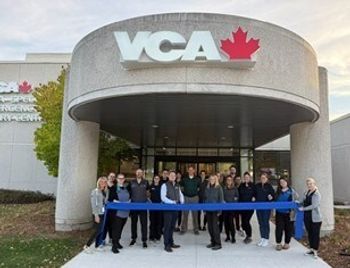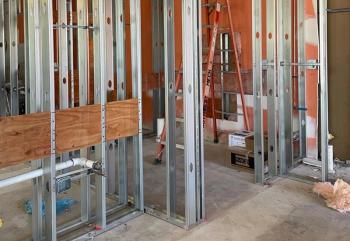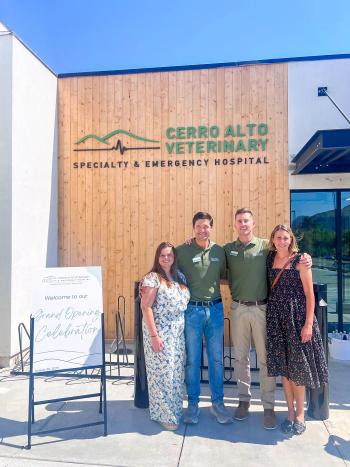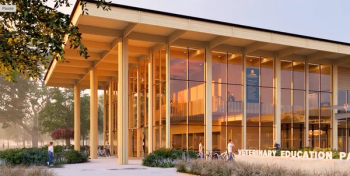
Learning and growing
Dr. Bill Wodiske, a 1982 Washington State University graduate and owner of three veterinary hospitals in the greater Phoenix area, has worked with architects and contractors to complete five separate building projects, including three leasehold designs, a leasehold remodel, and a free-standing facility. And apparently, the fifth project was the charm: Mountain Park Ranch Animal Hospital and Pet Resort took home a Merit Award in Veterinary Economics' Hospital Design Competition.
By Carolyn Chapman,
special assignments editor
Dr. Bill Wodiske, a 1982 Washington State University graduate and owner of three veterinary hospitals in the greater Phoenix area, has worked with architects and contractors to complete five separate building projects, including three leasehold designs, a leasehold remodel, and a free-standing facility. And apparently, the fifth project was the charm: Mountain Park Ranch Animal Hospital and Pet Resort took home a Merit Award in Veterinary Economics' Hospital Design Competition.
One Hospital Design Competition judge appreciated the space allocated for staff members' use in the 6,640-square-foot plan, especially the practice manager's office and the staff lounge. "The epoxy paint-chip flooring is effective and attractive," another judge remarked.
Preparing to build
Dr. Wodiske started Mountain Park Ranch Animal Hospital and Pet Resort 11 years ago in a 1,800-square-foot leasehold. He gambled on a new shopping center in an undeveloped suburb of Phoenix, because the housing seemed more dense and upscale than other communities in the area. He won big when the area drew an affluent population to live and shop. "I quickly attracted the top-quality clients I wanted," Dr. Wodiske says.
Eight years later, the tiny leasehold was starting to bulge at the seams. "I could see that the practice was going to outgrow the space," Dr. Wodiske says. Although he knew he wouldn't be ready to build a new facility for several years, he started searching for suitable land, hoping to maintain his client base by securing a lot near his hospital. And planning ahead paid off. Dr. Wodiske found an ideal site an eighth of a mile from his previous location in a new shopping development with a pharmacy and daycare.
Like many veterinarians, Dr. Wodiske encountered resistance when he approached the developer with his building plans. He met several times with the site development team to alleviate concerns about odor and noise. To secure final approval, he had to allow city inspections; meet the local homeowners' association landscaping requirements; and comply with the developer's codes, covenants, and restrictions.
Dr. Wodiske hired architect Robert Adams, of Robert Adams Architects Inc. in Tempe, Ariz., who had also helped him remodel a leasehold in Mesa, Ariz. "Maximizing the square footage on the three-quarter-acre site turned out to be our biggest challenge," Adams says.
While Dr. Wodiske asserts that he built this hospital for more space, his wife and hospital coordinator, Tris Wodiske, jokes that they built the hospital to board their own dogs. City codes prevented the addition of a second story, so Dr. Wodiske added a basement to accommodate extra boarding, a staff lounge, and a small apartment that team members use when they need to provide 24-hour patient care.
Dr. Wodiske says securing approval for the basement was easier than he expected, but the city did require an external stairwell, with a surprise price tag of $15,000. Staff members use the stairs frequently to escort dogs to the play yard, and the underground boarding gives dogs a cool place to stay when it's hot outside. Down the road, Dr. Wodiske plans to install Web cameras in the boarding areas and in the surgery suite so clients can check on pets online.
Choosing modern amenities
Mountain Park Ranch Animal Hospital and Pet Resort's stucco exterior with scored concrete block and painted metal draws attention to the modern facility. A row of metal plates featuring cutouts of animals spans the wide entryway and creates interesting shadows in Arizona's bright sunlight. At night, the practice backlights the animal shapes.
When clients arrive at the practice, they follow whimsical animal footprints in the concrete walkway to the front door. Separate entrance and exit doors encourage a circular traffic flow around the reception desk.
To add visual interest and bring lighting closer to the reception counter, Adams designed a suspended ceiling, which also helps control noise in the spacious area. And he created extra workspace for reception staff members by moving the reception desk away from the exam rooms.
The wall in the reception area sports soothing pale-lavender paint and a simple eggplant-colored border near the ceiling. Black-and-white photographs of staff members with their pets contribute to the sophisticated look and remind clients that pets are a personal priority for all team members. "We want clients to know we really care about all pets," Dr. Wodiske says.
Interior windows make it easy for clients to see into the grooming and cat boarding areas, which flank the reception area. And a glass case near the front entrance displays bladder stones, jawbones, an ostrich egg, and a bird's nest. A second case on the opposite side of the reception desk displays shells. "I added the cases to stimulate interest in the science of veterinary medicine," Dr. Wodiske says. Receptionists field most of clients' questions about the contents.
Epoxy paint-chip seamless flooring, a feature Dr. Wodiske discovered in a luggage shop in a local mall, lines the main areas of the hospital. The durable floor surface blends purple, gray, black, and white paint chips. "Flooring is always a nightmare," laments Dr. Wodiske. "I've never felt completely happy with my choices, but this has proved the best flooring I've found so far."
Five exam rooms span the hall behind the reception desk and bridge the public and working areas of the hospital with a front and back entrance in each. Corian tables in the exam rooms offer durability, while plastic circular backsplashes keep walls clean.
Behind the exam rooms, the treatment area accommodates one dry table and two wet tables that function as dental stations. Dental units, clipper blades, gas scavenging units, and drop-down anesthesia complete the workstation. Radiology, surgery, and the isolation area are all accessible from the treatment area.
During construction, Dr. Wodiske discovered that isolation was too small. To address the problem, Adams added a sliding glass door and took some space away from the adjacent food preparation area. On the other side of the facility, Adams carved space out of the surgery suite to create an office for the owner. "With limited building space, we had to find creative solutions to fit everything in," Dr. Wodiske says.
"Overall, this is the happiest I've been with any building project," he asserts. And the move offered one upside he didn't anticipate: improved staff retention. These days, he says, new staff members find him.
Carolyn Chapman, a former Veterinary Economics associate editor, is a freelance writer in Liberty, Mo.
Newsletter
From exam room tips to practice management insights, get trusted veterinary news delivered straight to your inbox—subscribe to dvm360.






